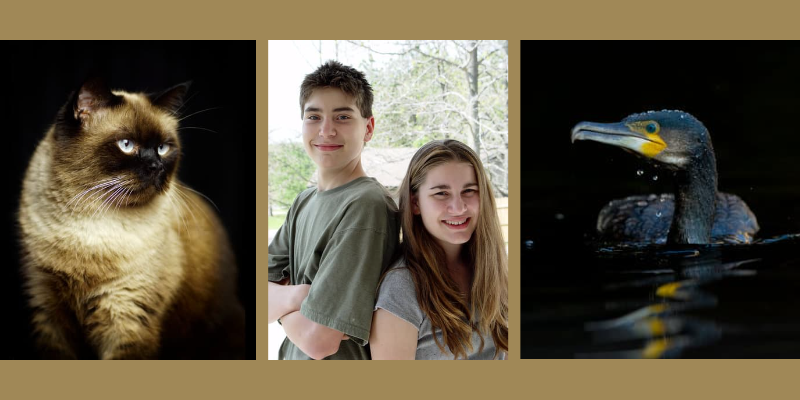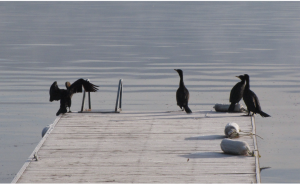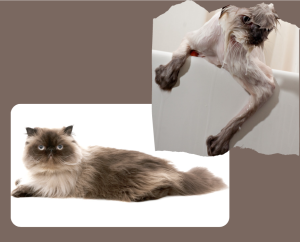
Scene 1: The lake.
My husband and I are inveterate, if amateur, water fowl watchers.We delight to observe the junior high antics of coots, the intensely punk look of mergansers and the aerial fishing techniques of osprey. But, among all the birds we commonly see, none is more stunning nor elegant in its self-presentation than the graceful cormorant. As it effortlessly glides across the water, the cormorant holds its head with aristocratic bearing, seeming to all the world totally unaware of what is passing beneath the surface. And, yet, without warning, this classically molded bird dives swiftly into the depths often to emerge with a glittering, flapping meal victoriously held in its beak. Since we are not fish, we take great delight in watching the beauty and grace of this particular water bird.
 One day, while gazing over one of the beautiful northwest Washington lakes, I suddenly noticed a large bird standing at the end of a dock. It was holding its wings at that angle birds use for exposing their feathers to the breezes, which is a beautiful sight when one is watching an eagle. In this case, however, the effect was ghastly. Gangly and unsightly, with uneven feathers poking down, this sight-of-sore-eyes clumsily took a few paces, giving us the sense that he might tumble over his webbed feet at any moment. When I pointed out this remarkably ugly bird to my husband, he stared long and hard before pronouncing its type.
One day, while gazing over one of the beautiful northwest Washington lakes, I suddenly noticed a large bird standing at the end of a dock. It was holding its wings at that angle birds use for exposing their feathers to the breezes, which is a beautiful sight when one is watching an eagle. In this case, however, the effect was ghastly. Gangly and unsightly, with uneven feathers poking down, this sight-of-sore-eyes clumsily took a few paces, giving us the sense that he might tumble over his webbed feet at any moment. When I pointed out this remarkably ugly bird to my husband, he stared long and hard before pronouncing its type.
“Diana, that’s a cormorant.”
No.It was not possible. This awkward, ill-favored bird on land could not be one and the same with the exquisite, beautiful bird of the lake. Yet, my husband was shortly proved right when the bird lifted off the dock and settled back onto the water. Shocking how a bird can go from repulsive to regal just by a change in its environment.
Scene 2: The cat.
Though we are dog-lovers-till-death-do-us-part people, we do enjoy the arrogant beauty of the feline world. Having owned many cats in my  lifetime, I have had numerous opportunities to watch them slinking, preening, and lording it over all the less exalted personages in their household. Perhaps the quintessential breed of feline hauteur is the Himalayan cat, with its extremely long fur and Siamese color markings. You know instantly that your are in the presence of imperious nobility when confronted by a lounging Himalayan.
lifetime, I have had numerous opportunities to watch them slinking, preening, and lording it over all the less exalted personages in their household. Perhaps the quintessential breed of feline hauteur is the Himalayan cat, with its extremely long fur and Siamese color markings. You know instantly that your are in the presence of imperious nobility when confronted by a lounging Himalayan.
Now, picture that same cat wet. It’s a vision, isn’t it? Instead of the highest attainment of the animal kingdom, one is confronted with a matted, woebegone creature who looks very silly, feels very sorry for itself, and is completely overwrought with efforts at tidiness. Your perception of the cat, as with the cormorant, is entirely dependent upon whether you find it in the particular environment in which it thrives.
Scene 3: My childhood.
 When it came to academics, I easily vaulted to the head of my class in algebra, English and French. But when it came to P.E. classes, I straggled in at the very back of the line. I was constantly hearing from my teachers, “Run faster, throw harder,” and, honestly, I tried with all my might to throw that softball more than ten feet! Nevertheless, it was simply not possible. No giftings in that direction for me.
When it came to academics, I easily vaulted to the head of my class in algebra, English and French. But when it came to P.E. classes, I straggled in at the very back of the line. I was constantly hearing from my teachers, “Run faster, throw harder,” and, honestly, I tried with all my might to throw that softball more than ten feet! Nevertheless, it was simply not possible. No giftings in that direction for me.
It soon became painfully obvious to my athletic father that I was not going to follow in his footsteps (that would be fulfilled much later by my half-brother who played pro football). Frankly, it was devastating to not be good enough to compete in sports, since that’s what my father valued.
Though I had straight A’s in my academic courses, I was always among the last chosen for team sports. Just like the cormorant and the cat, in the right environment, this kid was regal, and in the wrong one. . . well, you get the idea.
Scene 4: Your house, your child.
- When does your child shine? What activities bring out the star qualities, the bright eyes and enthusiastic voice? Is it devouring books or doing arithmetic problems or cooking dinner or working in the garden? Is it sports or language or science or dance or photography or machinery?
- Once you have that figured out (which can take time and patience, trial and error), you might next ask yourself, “When does my child crumple, overwhelmed with a task?” Is it reading or math or understanding recipes or getting dirty? It is tennis or grammar or chemistry or ballet or craft time or mowing the lawn?
Our part as parents, especially as homeschool parents, is to discover these areas and then to carefully, thoughtfully, humbly work with, not against, our unique children. The first challenge is to accept them as you find them. Do you have a cormorant-type child who is absolutely designed for the water? Or do you have a Himalayan-cat-type child who is utterly fitted for land? Rather than throwing the cat into the water or the bird onto land—to teach them “how to get along in this world”—maybe it would be better to learn to appreciate what they are good at, what they like, what their giftings truly are.
Examples:
An example of this that I love to use is Mikhail Baryshnikov, a former Russian star of the ballet. What do you suppose he got in trouble for when he was a little guy in school? Of course. Moving. But, oh, how glorious for all of us that he was wired to move so well! Though it might have been challenging to his parents and teachers when he was young, it was more than repaid as he got older and got training.
What about Oprah Winfrey? What do you suppose she got in trouble for when she was in school? If I were a betting woman, I’d wager big bucks that she was constantly in hot water for talking! And yet, that gifting is exactly what makes her a celebrity in her own right today.
Both of these examples show us the vital necessity of knowing our kids, learning what is wired into them, and then blessing it!
2 Challenges:
 The first challenge is to accept them.
The first challenge is to accept them.
The second challenge is to enjoy them.
If, deep in my heart of hearts, I really want a water bird rather than a cat, and keep throwing my cat into the water in hopes that it will develop a taste for swimming, my cat will either be disabled, flee from my presence, or wither up and die.
If, on the other hand, I can bring myself to the point where I like cats, where I enjoy brushing and playing appropriately with them (which precludes throwing them in the water!), my cat will begin to thrive and grow into the full stature of its cathood. If we can learn this lesson—to enjoy them while we parent them—we will eventually rejoice in how they turn out.
Cormorants, cats, and kids. . . The lessons are there for each of us to ponder.I wish you great joy as you discover how to delight in wet birds, dry felines, and your own unique children.
No Comments
There are no comments yet, add one below.

